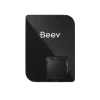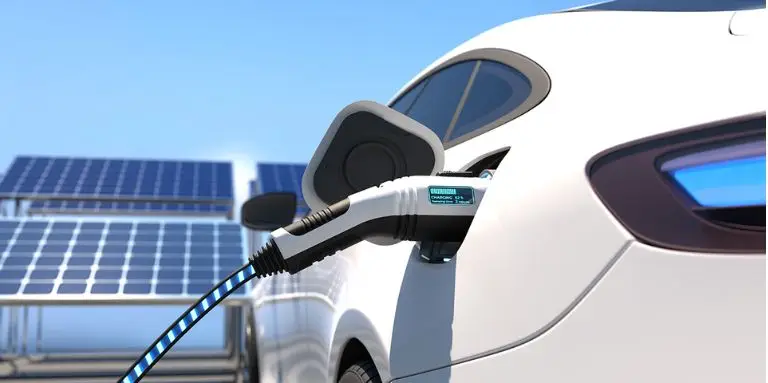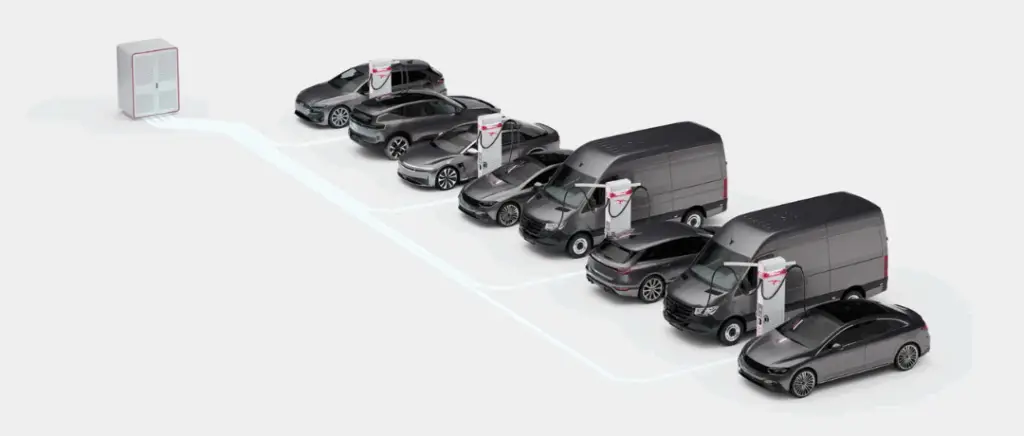Annual Incentive Tax (TAI) 2025: everything you need to know about the new obligation for fleets of more than 100 vehicles
Do we still have to comply with the LOM greening quotas?
Until the TAI came into force on 1 March 2025, companies with more than 100 vehicles had to comply with the greening quotas set by the Mobility Orientation Law (LOM). These quotas have now been abolished: the LOM timetable has disappeared for car fleets, and only mopeds and motorbikes remain covered. Instead, the TAI applies to all companies with large fleets, changing the regulatory framework for the greening fleets.
Abolition of LOM quotas and introduction of the TAI (annual incentive tax)
The adoption of the Annual Incentive Tax (TAI) in the Finance Act for 2025 has led to the abolition of the greening quotas introduced by the LOM. From now on, a new Article of the Environment Code (L224-9-1) requires companies to pay an annual incentive tax on the purchase of low-emission light vehicles. This tax is based on the "gap factor", which measures the difference between the actual proportion of clean vehicles in the fleet and the target objective set by the regulations.
What are the new target percentages for the integration of clean vehicles?
The TAI sets target percentages for the inclusion of low-emission vehicles in fleets, which change every year:
| Calendar year | Target percentage of clean vehicles |
|---|---|
| 2025 | 15 % |
| 2026 | 18 % |
| 2027 | 25 % |
| 2028 | 30 % |
| 2029 | 35 % |
| 2030 | 48 % |
These percentages correspond to the minimum proportion of low-emission vehicles to be included in the company's total fleet each year, on pain of being subject to the Annual Incentive Tax (TAI).
Is TAI more demanding than LOM quotas?
Differences in logic and basis of assessment between LOM and TAI
The Annual Incentive Tax (TAI) introduced in 2025 is based on a different logic to that of the greening quotas introduced by the Loi d'Orientation des Mobilités (LOM). Whereas the LOM imposed a quota of clean vehicles only on vehicles renewed each year (for example, a threshold of 20% from 2024), the TAI sets a target objective for the company's entire fleet. In 2025, this rate is set at 15% of the total fleet, which may seem less restrictive at first glance. However, this comparison is misleading because the basis of calculation is different: the LOM only considered renewed vehicles, whereas the TAI applies to all vehicles owned by the company.
This difference in basis makes the TAI potentially more severe, because a company that complied with the LOM quotas when renewing its fleet may find itself in a situation of non-compliance if the proportion of clean vehicles in its overall fleet is lower than the target set. TAI therefore aims to encourage a more comprehensive and sustainable greening of the fleet, beyond simple renewal.
Summary table of the difference between LOM (Loi d'Orientation des Mobilités) and TAI (Taxe Annuelle Incitative)
| Criteria compared | LOM (Mobility Orientation Law) | TAI (Annual Incentive Tax) | Consequences for companies |
|---|---|---|---|
| The logic of obligation | Quota on vehicles renewed each year | Target objective for the company's entire fleet | TAI requires a global vision, not just a focus on renewal |
| Calculation basis | Only renewed vehicles | All vehicles owned by the company | The TAI percentage applies to a much broader base |
| Example of threshold | 20 % of clean vehicles on renewal (2024) | 15 % of clean vehicles across the fleet (2025) | An apparently lower TAI target, but in reality more demanding |
| Risk of non-compliance | Regulatory non-compliance | Payment of an annual incentive tax | Even a company that complies with the LOM may be liable to pay TAI |
| Objective | Gradual greening on renewal | Comprehensive and sustainable greening of the entire fleet | Obligation to anticipate the transition for the entire fleet |
Impact on companies already complying with the LOM
For companies that were already complying with the LOM quotas, the introduction of TAI may represent a major change. Even if they were renewing at least 20% of their vehicles with clean models, they will now have to ensure that the proportion of low-emission vehicles in their total fleet is sufficient. If they fail to meet this new overall target, they will be subject to the annual incentive tax.
In addition, the TAI applies to each company taken in isolation, without consolidation with its subsidiaries, unlike the LOM, which could take account of vehicles managed indirectly via subsidiaries in which more than 50% is owned. This distinction can also change the tax base and complicate management for multi-entity groups.
Basically, TAI introduces a broader and more global constraint, forcing companies to review their fleet management to integrate more clean vehicles throughout their fleet, and not just when renewing it.
Which companies are affected by TAI?
The Annual Incentive Tax (TAI) applies to all entities liable for Vehicle Use Tax (VAT), i.e. any structure using vehicles in the course of an economic activity. This obligation is not limited to commercial companies: it also applies to the professions, associations involved in economic activity, public industrial and commercial establishments, and any legal or natural person liable for VAT.
However, the TAI only applies to companies with a fleet of 100 or more vehicles used for business purposes, unlike the TVU, which applies from the first vehicle.
Definition of a "business" for tax purposes
For the purposes of TAI and TVU, the notion of "business" is understood in the tax sense, in accordance with Articles 256 A and 256 B of the General Tax Code. This therefore includes all persons liable to VAT and acting as such, regardless of their legal form.
This broad definition ensures that the tax applies to companies as well as to other economic structures, provided that they are subject to VAT and use vehicles for their business activities.
100-vehicle threshold: who is taxed?
The scope of TAI is limited to companies with an average annual fleet of at least 100 vehicles assigned to an economic activity. This threshold is assessed at the level of each individual company, without taking into account vehicles owned by subsidiaries or other group entities. The size of the fleet is calculated on the basis of the length of time the vehicles are used during the calendar year:
if the ratio obtained exceeds 100, the company is liable for TAI. The declaration and payment procedures are aligned with those for UBT, with TAI being declared and paid simultaneously using the same tax forms.
How do you calculate the size of the fleet subject to TAI?

The size of the fleet subject to the Annual Incentive Tax (TAI) is assessed on the basis of the number of vehicles assigned to an economic activity within the company, and not at the level of a group or its subsidiaries.
To determine whether a company crosses the 100-vehicle threshold, an annual ratio needs to be calculated: this is the sum of the time each vehicle is used for business activity over the calendar year, divided by the number of days in the year (365 or 366).
If this ratio is greater than 100, the company falls within the scope of TAI.
Calculated at company level, not group level
Unlike the previous LOM regulations, which allowed the aggregation of vehicle fleets managed directly or indirectly via subsidiaries, the TAI is assessed exclusively at the level of each individual company. Vehicles owned by subsidiaries or other group entities are therefore not taken into account when calculating the fleet of the company liable for the tax.
This approach aims to clarify tax liability and avoid the artificial threshold effects created by the group structure.
Taking account of vehicle assignment times
Calculating the size of the fleet is not simply a matter of counting the number of vehicles on the road. 1 January or 31 December. It takes into account the actual length of time each vehicle is used for business purposes over the calendar year.
Thus, a vehicle delivered or withdrawn during the year will be taken into account on a pro rata temporis basis. The date on which a vehicle is included in the fleet corresponds to the date on which it is first used for business purposes, generally the date of registration. This method of calculation accurately reflects the reality of the fleet used over the year, and ensures fair taxation between companies with different renewal cycles.
Example of how to calculate the size of the fleet subject to TAI
Suppose a company has several vehicles, not all of which were present throughout 2025:
Vehicle A: used from 1 January to 31 December 2025 (365 days)
Vehicle B: delivered on 1 March 2025, used until 31 December 2025 (306 days)
Vehicle C: delivered on 1 July 2025, used until 31 December 2025 (184 days)
Vehicle D: used from 1 January to 30 June 2025 (181 days)
To calculate the average annual size of the fleet, add up the total number of days each vehicle is assigned, then divide by the number of days in the year (in this case, 365).
Calculation :
Vehicle A: 365 days
B vehicle: 306 days
Vehicle C: 184 days
Vehicle D: 181 days
Total days on assignment :
365 + 306 + 184 + 181 = 1036 days
Fleet size :
1,036 days ÷ 365 days = 2.84
In this example, the average annual fleet size is 2.84 vehicles.
The company therefore does not reach the threshold of 100 vehicles and is not concerned by the TAI.
To remember:
This calculation is made by adding up the number of days each vehicle has been on the road over the calendar year, then dividing by 365 (or 366 for a leap year). If the result is greater than 100, the company falls within the scope of TAI..
How do you manage vehicles delivered during the year?
The regulations governing the Annual Incentive Tax (TAI) provide for a specific mechanism for vehicles that are not present in the fleet throughout the calendar year. For each vehicle, only the actual time it is used for business purposes is taken into account in the calculation.
In concrete terms, if a vehicle is delivered or withdrawn during the year, its contribution to the calculation of the size of the fleet will be proportional to its period of use. This prorata temporis approach provides a faithful representation of the company's operational reality and avoids penalising fleet renewals during the year.
Prorated calculation for 2025 depending on the date of entry into force
For the year 2025, the calculation of the TAI presents an important particularity: the tax only came into force on 1 March 2025. As a result, the calculation is not based on the whole year, but only on the remaining 306 days (from 1 March to 31 December 2025). According to the clarifications provided by the tax authorities, the amount of tax for 2025 will have to be calculated on a pro rata basis, i.e. X/306th of the amount that would have been due for a full year.
This prorating will only apply to 2025; from 2026, the calculation will be based on a full year (X/365th or X/366th for leap years).
Which date should be used: order or registration?
The legislation is clear on this point: it is the date on which the vehicle begins to be used for business purposes that must be used to determine its inclusion in the fleet. In practical terms, this date generally corresponds to the vehicle's registration date, and not the order date. This approach differs from that which prevailed under the LOM, where orders could be taken into account.
For the annual publication of greening efforts (an obligation maintained despite the abolition of LOM quotas), the date of registration also seems to be the reference to be used, given the explicit reference in the article concerned to the TAI regime.
Practical example:
A vehicle ordered in January 2025 but registered on 15 April 2025 will only be taken into account in the calculation of the TAI 2025 for the period from 15 April to 31 December 2025, i.e. 261 days out of the 306 days of application of the tax in 2025.
How is the amount of TAI calculated?
The calculation of the Annual Incentive Tax (TAI) is based on a complex formula that takes into account several parameters specific to the composition of the company's fleet. The tax is determined on the basis of the difference between the actual proportion of low-emission vehicles in the fleet and the target set by the regulations. More specifically, the amount of the TAI is calculated by multiplying a flat rate by the number of vehicles required to meet the target, while taking into account mark-up factors for certain types of vehicle.
The formula includes the "deviation factor", which measures the difference between the actual situation of the fleet and the legal target. This factor is then multiplied by the total number of vehicles and by a unit rate to determine the final amount of the tax. The aim of this approach is to provide companies with a financial incentive to speed up the greening of their fleets. vehicle fleet.
Presentation of the calculation formula and practical examples
The method for calculating TAI can be summarised as follows:
1- Determine the average annual fleet size (as explained above)
2- Calculate the current proportion of low-emission vehicles in the fleet
3- Compare this proportion with the target for the year (15% in 2025).
4- Determine the number of vehicles needed to reach the target
5- Applying the flat rate and any surcharges
For 2025, the calculation must be adjusted in proportion to the number of days the tax was in force (effective from 1 March), i.e. X/306th of the amount that would have been due for a full year.
Simplified example :
A company has a fleet of 200 vehicles in 2025, of which only 20 are low-emission (i.e. 10% of the fleet).
2025 target: 15%
Gap: 5% (equivalent to 10 missing vehicles)
The amount of the tax will be calculated on the basis of these 10 missing vehicles, multiplied by the applicable flat rate and prorated over 306 days.
Use of simulation tools to anticipate tax
Use of simulation tools to anticipate tax
Given the complexity of calculating the TAI, a number of simulation tools have been developed to help companies anticipate their exposure to this new tax.
These simulators enable fleet managers to :
- Evaluate the potential amount of tax based on the current composition of their fleet
- Test different scenarios for the development of their fleet
- Optimise their renewal strategy to minimise the tax impact
- Plan the investments needed to meet regulatory targets
The use of these tools becomes particularly strategic in a context where target objectives are gradually increasing until 2030, making medium-term planning essential to control the fiscal costs associated with fleet management.
For a precise, personalised analysis, we recommend consulting a fleet tax expert or using the simulators provided by specialist players in the sector.
Specific features depending on the type of vehicle
TAI distinguishes several categories of vehicle and applies specific rules according to their nature. The company carsthe utilitiespassenger cars and light commercial vehicles rechargeable hybrids are not treated in the same way, particularly when determining their tax base or environmental impact.
This differentiation is designed to take into account both the professional uses and the technical characteristics of each type of vehicle.
Company vehicles: treated as commercial or private?
Company vehicles (CVs) are, in principle, treated in the same way as commercial vehicles (CUVs) for the purposes of TAI, subject to a technical condition: the rear seat anchorage points must not be considered "accessible". If this condition is met, the vehicle will be treated as a commercial vehicle, which may have an impact on the calculation of the tax.
However, further clarification of the rules applicable to these vehicles is awaited by decree or from the tax authorities.
Calculating CO2 emissions for plug-in hybrids
For the plug-in hybrid vehicles (PHEV), the "regulations lay down a precise method for calculating CO₂ emissions. The rate to be used is that shown on the vehicle registration document, in box V7. This official rate, which complies with the European standard in force, is used as a reference to determine whether the vehicle can be considered as low-emission and, if so, benefit from a bonus or a favourable increase in the calculation of the TAI.
This rule is designed to ensure objectivity and transparency in the environmental classification of plug-in hybrid vehicles.
What are the tax increase factors?
The TAI provides for mark-up or bonus/malus factors depending on the category of vehicle and its level of CO₂ emissions. Some vehicles benefit from a bonus (or a favourable mark-up) as soon as their carbon footprint is low or that they are considered to have low emissions.
Conversely, other vehicles may be subject to a higher surcharge depending on their use or environmental category. These surcharges are applied to the length of time the vehicle is used when calculating the tax, which has a direct impact on the amount payable.
Bonus/malus based on carbon footprint and vehicle category
The environmental bonus and ecologic malus is based on the vehicle's environmental rating (low emissions or low carbon footprint) and its category (passenger car, light commercial vehicle, etc.), passenger vehicle for special use, etc.).
The greener the vehicle, the higher the bonus coefficient applied in calculating the TAI, which reduces the tax burden for the company. Conversely, the less environmentally-friendly vehicles have a shorter useful life, which increases the tax due.
Table of applicable surcharge rates
| Vehicle category | Environmental qualification | Surcharge rate | Calculation formula (2025) |
|---|---|---|---|
| M1 or N1 vehicle used for passenger transport | Low carbon footprint | 50 % | (Useful life x 1.5) / 306 |
| Special-purpose passenger vehicle or utility vehicle | Low emissions | 100 % | (Useful life x 2.0) / 306 |
| Special-purpose passenger vehicle or utility vehicle | Low carbon footprint | 150 % | (Useful life x 2.5) / 306 |
M1: passenger cars
N1: light commercial vehicles
To remember:
- The cleaner the vehicle (low carbon footprint or low emissions), the higher the mark-up rate, which reduces the tax burden.
- For 2025, the calculation formula is prorated over 306 days (from 1 March to 31 December).
How do I declare and pay TAI?
The Annual Incentive Tax (TAI) is declared and paid at the same time as the Vehicle Use Tax (TVU). Companies must declare the AIT according to their VAT regime, using the appropriate tax forms. The amount of the tax must be entered on the corresponding schedule or return, depending on the company's tax regime.
This synchronisation with the TVU will simplify the administrative procedures for the companies concerned.
VAT return procedures
The procedures for declaring and paying VAT vary according to the VAT regime applied to the business:
- Standard VAT system :
TAI is declared on theannex 3310-A the CA3 return, filed for the month of December or the fourth quarter of the year in which the tax is due.
- Simplified VAT scheme :
The tax is declared on the annual return CA12/CA12Efiled in respect of the financial year in which the tax became chargeable.
- Other cases :
TAI is declared on theappendix 3310-A-SDThis must be submitted by 25 January of the year following the year in which the tax became payable.
Maintenance of an annual vehicle statement
Companies liable for TAI must provide the tax authorities with an annual summary statement of the vehicles assigned to their business and falling within the scope of the tax. This document, the exact content of which will be specified by decree, will have to include all relevant information on the vehicles concerned (dates of assignment, environmental characteristics, etc.). The aim of this requirement is to guarantee the transparency and traceability of the data declared, and to facilitate any checks by the authorities.
In a nutshell:
TAI is declared and paid at the same time as VAT, depending on the company's VAT regime, and requires an annual summary statement to be kept of the vehicles concerned. Companies must therefore plan ahead to collect and keep all the data they need to meet these tax obligations.
Publication obligations and forthcoming legislative changes
Obligation to publish greening efforts annually
Despite the abolition of the LOM's greening quotas, private companies and public bodies engaged in profit-making activities are still required to publish their greening efforts annually. This obligation is set out inarticle L224-12 of the Environmental Code, which now refers to the new TAI system. Publication must take place before 30 September each year for the previous year, via the official website data.gouv.
Companies must therefore make public the data relating to the composition and ecological transition of their vehicle fleets, in accordance with the transparency requirements imposed by the legislator.
Towards a lowering of the 100-vehicle threshold?
To date, the regulations do not provide for a lowering of the 100-vehicle threshold for liability to TAI. However, parliamentary debates are underway on this point. A bill tabled by MPs Gérard Leseul and Jean-Marie Fiévet suggests lowering this threshold by 2028, in order to extend the scope of TAI to more companies.
However, this proposal has not yet been placed on the agenda of the French National Assembly, and there is no precise timetable. The companies concerned should therefore keep a close eye on legislative developments on this subject, particularly during the examination of the Finance Bill for 2026.
What is the status of the proposed law on the greening of fleets?
The draft law (PPL) put forward by MPs Gérard Leseul and Jean-Marie Fiévet, which aims to make fleets greener and lower the threshold for tax liability, is currently being rewritten. This revision is necessary to ensure the text is consistent with the TAI, recently introduced by the Finance Act for 2025.
At this stage, it is not certain that the bill will be included on the agenda of the National Assembly. However, some of its measures, such as lowering the threshold or excluding certain plug-in hybrid (PHEV) models, could be included in the Finance Bill for 2026, which is due to be examined next autumn.
VAT, benefits in kind and taxation of company cars: what employers and employees need to know
In addition to the greening and TAI obligations, the management of company cars also involves major issues in terms of VAT and benefits in kind, for both the company and its employees.
Benefit-in-kind rates for company cars
L'benefit in kind is added to the employee's gross salary and is subject to social security contributions and income tax. It can be assessed :
- Actual: total cost borne by the employer (hire, maintenance, insurance, fuel if paid for).
- Fixed price :
- With fuel paid for by the employer: 30 % of the purchase cost (incl. VAT) of the new vehicle per year (capped at €9,900 for an electric vehicle).
- Without fuel costs: 9 % of the purchase cost (incl. VAT) of the new vehicle per year.
Example:
- Vehicle purchased for €30,000 incl. VAT, fuel paid for :
Benefit in kind = 30 % x €30,000 = €9,000 per year. - Fuel not covered :
Benefit in kind = 9 % x €30,000 = €2,700 per year.
Impact on the employee
- Social security contributions: the employee pays social security contributions on this additional amount (approximately 22 % for the employee portion).
- Income tax: the benefit in kind increases taxable income.
- VAT: the employee does not pay VAT directly, but the employer must collect it on the value of the benefit in kind if the service is considered onerous.
Example of a figure for an employee earning the minimum wage (€21,203 gross per year in 2025) with a benefit in kind of €2,700:
- New gross salary: €21,203 + €2,700 = €23,903
- Employee contributions (approximately 22 %) :
2,700 x 22 % ≈ €594 additional costs/year - Income tax: depends on the tax household, but tax income increases by €2,700
VAT on company cars
- Private cars: VAT is not recoverable on the purchase, but is recoverable on maintenance and fuel (excluding petrol for private cars, with some exceptions).
- Commercial vehicles: VAT recoverable on purchase, maintenance and fuel.
- Benefit in kind: if the provision of services is considered to be for consideration, the employer must collect VAT on the value of the benefit in kind (standard rate: 20 %).
Example for a benefit in kind of €2,700 :
- VAT collected by the employer: €2,700 x 20 % = €540 (to be paid to the government).
Summary of rates and salaries
| Elements | Rate / Amount 2025 | Example (€30,000 vehicle) |
|---|---|---|
| Benefits in kind (lump sum) | 9 % or 30 %/year | 2,700 € or 9,000 €/year |
| Employee contributions | ~22 % benefit in kind | 594 out of €2,700 |
| VAT on benefits in kind | 20 % | 540 out of €2,700 |
| Gross salary affected | + amount of benefit in kind | +€2,700 or +€9,000 |
To remember:
The allocation of a company car increases the employee's gross salary by the amount of the benefit in kind, which is subject to social security contributions and income tax. If VAT is applicable, the employer must collect it on this value. The employee does not pay VAT directly, but bears the tax and social impact of the benefit in kind added to his or her income.
Conclusion
The introduction of the Annual Incentive Tax (AIT) in 2025 will radically transform the management of company car fleets. From now on, companies with more than 100 vehicles will not only have to rethink their greening strategy, but also adapt to new reporting and tax obligations, particularly in terms of VAT and benefits in kind. The abolition of LOM quotas in favour of an overall target for the entire fleet makes compliance more demanding, and means that renewals and choices of motorisation have to be brought forward even further.
Against this backdrop, the integration of electric cars, the deployment of charging points and the optimisation of the electric fleet are becoming essential levers for meeting regulatory requirements while controlling the financial impact of TAI. It is in the interests of fleet managers to rely on specialised tools and solutions such as the fleet manager offered by Beev to effectively manage the transition and ensure their company's compliance with a constantly changing tax and legislative environment.

































